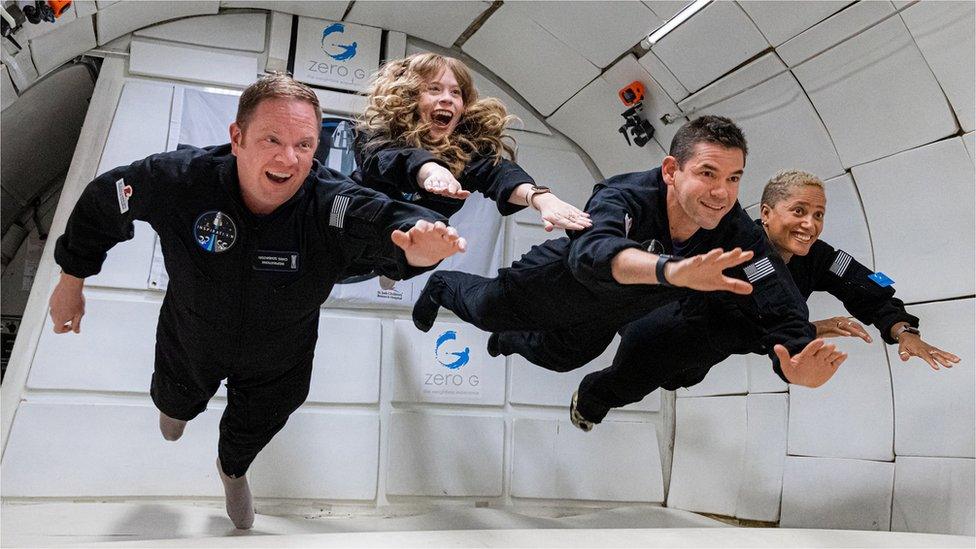SpaceX Inspiration4 mission: Four 'amateur astronauts' blast off into space
- Published
- comments

(L-R) Sembroski, Arceneaux, Isaacman and Proctor have trained for six months
SpaceX has launched the world's first ever all-civilian mission into orbit.
The four "amateur astronauts" blasted off from Florida's Kennedy Space Center at 8:02pm local time (1:02am in the UK).
The trip has been paid for by US billionaire businessman Jared Isaacman, who is one of the four person crew travelling to space.
Who is Jared Isaacman?
Billionaire Jared Isaacman is paying for the mission
Jared Isaacman dropped out of school aged 16 and started a business in his parents' basement that eventually became Shift4, a credit card payment company.
The billionaire, who is also a pilot, said: "I truly want us to live in a world 50 or 100 years from now where people are jumping in their rockets and there are families bouncing around on the moon with their kid in a spacesuit."
The mission making history
The mission comes after Sir Richard Branson's flight aboard his Virgin Galactic rocket plane on 11 July, and fellow billionaire Jeff Bezos' Blue Origin trip to space nine days later.
By international standards Virgin Galactic's mission did not actually go into space and the Blue Origin's mission only made it into space by a few miles.
But this mission, named Inspiration4, is different.
A SpaceX craft carrying the crew will go into orbit, circling the Earth for three days.
Yuri Gagarin was the first person in space 60 years ago
It's 60 years since Soviet Union cosmonaut Yuri Gagarin became the first person in space, since then fewer than 600 people have followed in his footsteps.
Most of those have been astronauts or cosmonauts who are military-trained and flying on government-funded missions.
"When this mission is complete, people are going to look at it and say, 'It was the first time everyday people could go to space'," Jared Isaacman said.
A healthcare worker, a science educator and a data analyst will join Isaacman on the flight. The group will spend their time doing experiments and looking at Earth through a large domed window.
The billionaire is using the trip to raise $200m (拢146m) for St Jude Children's Research Hospital in Tennessee in the US and says the donation to St Jude's "vastly exceeds the cost of the mission".
'Hey, do you want to go to space?'
Isaacman, Proctor, Arceneaux and Sembroski have trained for six months
The rest of the crew includes; Hayley Arceneaux, a healthcare worker at St Jude's Hospital. Now 29, Ms Arceneaux was treated for bone cancer at the hospital as a 10-year-old.
Dr Sian Proctor, a 51-year-old scientist who actually came close to being a Nasa astronaut in 2009 but missed out in the final round of selection.
And Chris Sembroski, a 42-year-old US Air Force veteran who works as an engineer with aerospace company.
Six months ago, the three were going about their everyday lives. Since then, they've been on a quick course on how to be an astronaut, training with SpaceX in its capsule simulator.
Talking about her surprise selection for the crew, Hayley Arceneaux said: "I think I'm the only person ever to just get a phone call saying, 'Hey, do you want to go to space?'."
The spacecraft
A large glass dome will allow the crew to look down on Planet Earth
Elon Musk's company SpaceX will take the four-person crew into orbit.
Their spacecraft called Dragon will sit on top of a Falcon-9 rocket during lift off, before detaching once it's left Earth's atmosphere.
The ship will reach a height above the Earth of 575km (360 miles), which is about 150km higher than the International Space Station (ISS).
SpaceX launches Falcon Heavy and lands all three rocket boosters for the first time. Pictures: SpaceX
A large domed window on the craft has replaced a hatch which would normally be used to dock with the ISS, but isn't needed for this mission.
After three days the craft will re-enter the Earth's atmosphere and will splashdown in the ocean.
- Published14 September 2021
- Published12 July 2021
- Published20 July 2021
- Published23 March 2021
